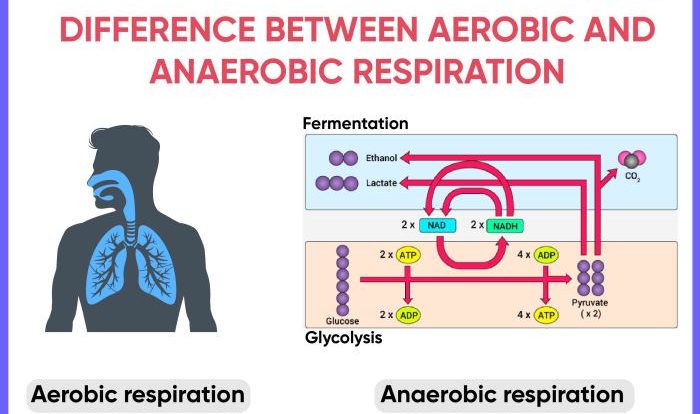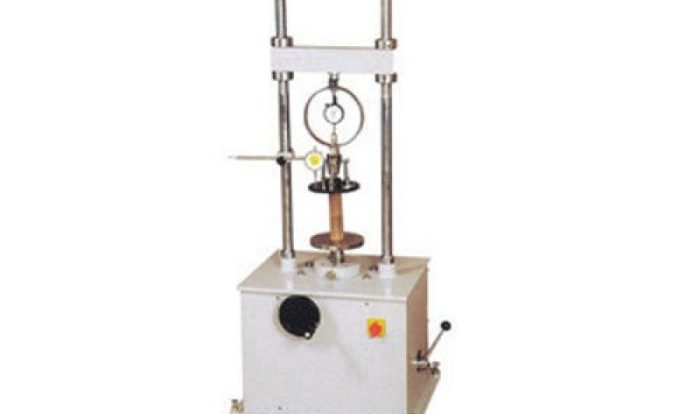The digestive system of a rabbit diagram provides a comprehensive visual representation of the unique digestive anatomy of these herbivorous animals. This intricate system is characterized by its adaptations for efficient nutrient extraction from plant-based diets.
Rabbits possess a complex digestive tract that enables them to effectively process and ferment plant material. Understanding the structure and function of their digestive system is essential for ensuring their optimal health and well-being.
Overview of the Digestive System of a Rabbit
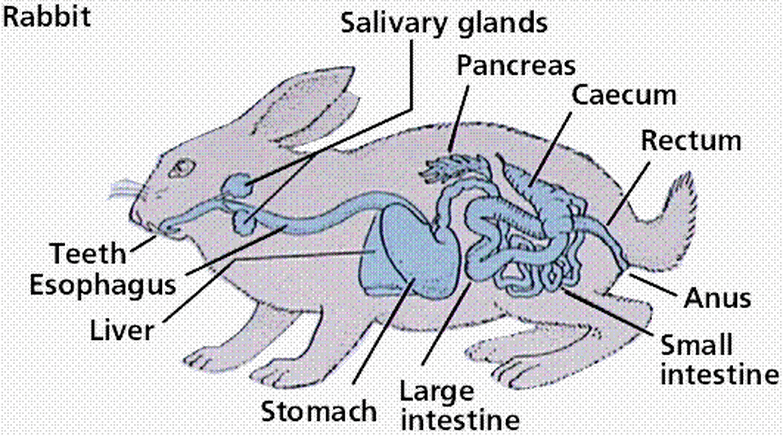
The digestive system of a rabbit is a complex and highly specialized system adapted to their herbivorous diet. It consists of a long and convoluted digestive tract that allows for the efficient breakdown and absorption of nutrients from plant material.
The rabbit’s digestive system also features unique adaptations, such as coprophagy and caecotrophy, that contribute to their overall digestive efficiency.
The main components of the rabbit’s digestive system include the mouth, esophagus, stomach, small intestine, large intestine, and rectum. Each organ plays a specific role in the digestive process, from the initial ingestion of food to the final expulsion of waste products.
The rabbit’s digestive system is adapted to handle a diet primarily composed of fibrous plant material. The teeth of rabbits are specially designed for gnawing and grinding tough plant matter, while the long and coiled digestive tract allows for the efficient breakdown and absorption of nutrients.
The rabbit’s stomach is relatively small, but it contains a unique muscular lining that helps to break down food particles.
One of the most distinctive features of the rabbit’s digestive system is coprophagy, the practice of consuming their own fecal pellets. Coprophagy allows rabbits to reingest partially digested food and further extract nutrients from it. This process is essential for rabbits to obtain the maximum nutritional value from their diet.
Another unique aspect of the rabbit’s digestive system is caecotrophy, the production of soft, mucus-covered fecal pellets that are rich in nutrients. Ccaecotrophs are produced in the cecum, a large pouch located at the junction of the small and large intestines.
Rabbits consume caecotrophs directly from the anus, which provides them with essential nutrients that would otherwise be lost in the feces.
Anatomy of the Digestive Tract
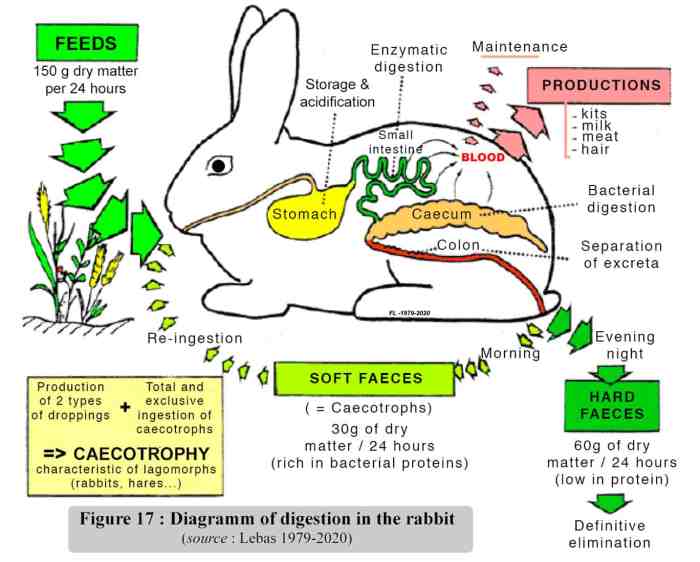
| Organ | Rabbit | Other Mammals |
|---|---|---|
| Mouth |
|
|
| Esophagus |
|
|
| Stomach |
|
|
| Small Intestine |
|
|
| Large Intestine |
|
|
| Rectum |
|
|
Digestive Processes
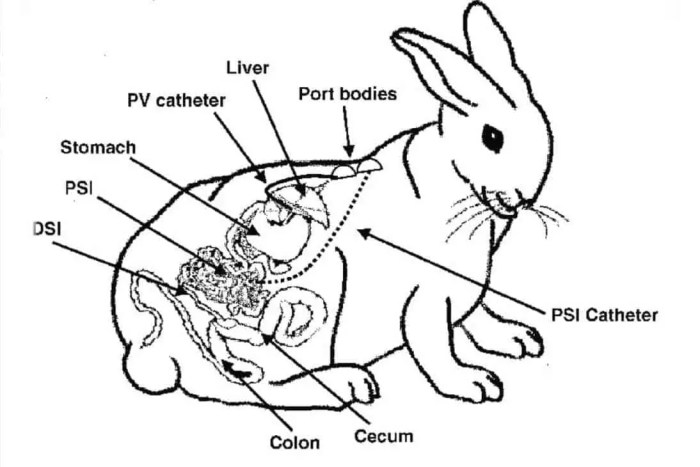
The digestive process in rabbits begins with the ingestion of food, which is then chewed and ground by the teeth. The saliva produced in the mouth contains enzymes that begin the breakdown of carbohydrates. The food then passes through the esophagus into the stomach, where it is further broken down by gastric juices.
From the stomach, the partially digested food moves into the small intestine, where most of the absorption of nutrients takes place. The small intestine is lined with villi and microvilli, which increase the surface area for absorption. The pancreas and liver produce enzymes and bile that aid in the digestion and absorption of nutrients.
The large intestine, which includes the cecum and colon, is where fermentation takes place. Bacteria in the cecum break down cellulose and other complex carbohydrates that cannot be digested in the small intestine. The products of fermentation, including volatile fatty acids, are absorbed by the rabbit and provide an important source of energy.
The final stage of digestion occurs in the rectum, where water is absorbed from the remaining waste material. The waste material is then expelled through the anus as feces.
Nutritional Requirements
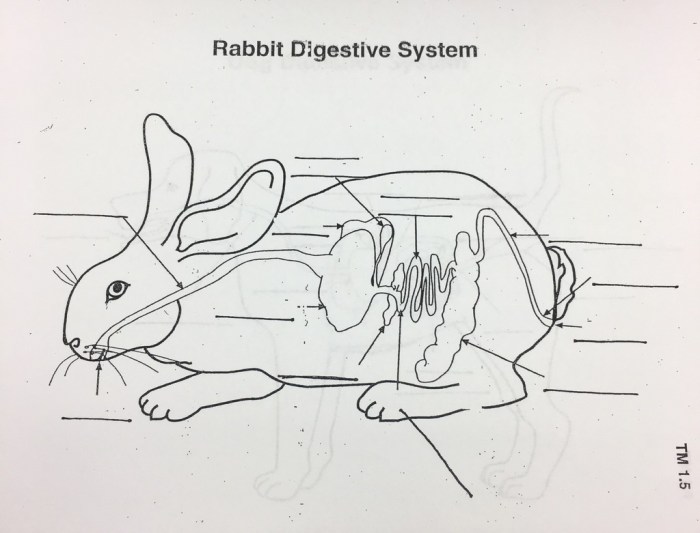
Rabbits have specific nutritional requirements to maintain their health and well-being. Their diet should be primarily composed of high-quality hay, which provides them with fiber, energy, and essential nutrients. Rabbits also need a small amount of fresh vegetables and fruits to provide them with vitamins, minerals, and antioxidants.
| Nutrient | Source |
|---|---|
| Fiber | Hay, grass |
| Protein | Hay, pellets, vegetables |
| Carbohydrates | Hay, pellets, vegetables, fruits |
| Fats | Hay, pellets, seeds |
| Vitamins | Vegetables, fruits, hay |
| Minerals | Hay, pellets, vegetables, fruits |
A balanced diet is essential for rabbit health. A diet that is too high in fiber can lead to digestive problems, while a diet that is too low in fiber can lead to obesity and other health issues.
Digestive Disorders
Rabbits are prone to a variety of digestive disorders, including:
- Gastrointestinal stasis (GI stasis): A condition in which the digestive tract stops moving, leading to a buildup of gas and toxins in the body.
- Diarrhea: A condition in which the feces are loose and watery.
- Constipation: A condition in which the feces are hard and dry.
- Enteritis: An inflammation of the small intestine.
- Colitis: An inflammation of the large intestine.
The symptoms of digestive disorders in rabbits can vary depending on the underlying cause. However, common symptoms include:
- Loss of appetite
- Weight loss
- Lethargy
- Abdominal pain
- Diarrhea or constipation
- Vomiting
If you suspect that your rabbit has a digestive disorder, it is important to seek veterinary attention immediately. Early diagnosis and treatment can improve the chances of a successful recovery.
Preventive measures can help to reduce the risk of digestive disorders in rabbits. These measures include:
- Providing a diet that is high in fiber and low in fat.
- Making sure that your rabbit has access to fresh water at all times.
- Keeping your rabbit’s living area clean and free of debris.
- Regularly deworming your rabbit.
- Taking your rabbit to the veterinarian for regular checkups.
FAQ Compilation: Digestive System Of A Rabbit Diagram
What is the unique characteristic of a rabbit’s digestive system?
Rabbits possess a specialized digestive system that allows them to ferment and extract nutrients from plant-based diets, including a large cecum and the practice of coprophagy and caecotrophy.
Why is understanding the rabbit’s digestive system important?
Comprehending the rabbit’s digestive system is crucial for ensuring their optimal health, as it influences their nutritional requirements, digestive disorders, and overall well-being.


